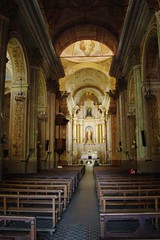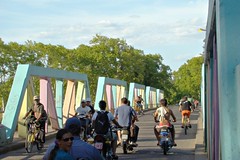 In the past, people voted for parties. But the candidates were important. They were expected to support the party platform, but also to do things independently, since a party's legislative bloc is not a committee. Otherwise it would be simpler to choose one representative per party and give each a certain number of beans to represent their voting power.
In the past, people voted for parties. But the candidates were important. They were expected to support the party platform, but also to do things independently, since a party's legislative bloc is not a committee. Otherwise it would be simpler to choose one representative per party and give each a certain number of beans to represent their voting power.
When Resolution 125 was killed in the Senate, the Kirchners realized that legislators were not beans they could count and hold in their hands. But Cristina and Néstor still need their beans. Now they're dangerously close to losing the majority, they'll do anything to retain it, including the latest fad: "testimonial" candidates.
Testimonial candidates are the quintessential beans. They're not even expected to get elected and then vote as the party leader tells them: their only function is to bring in votes. They're expected to resign without even taking office and leave their place to their stand-ins and to the next ones in the list. This is so because testimonial candidates must perforce be highly visible characters with political influence, and these are already taken up, mostly at executive positions, so they're not to be "wasted" as mere beans.
A few weeks ago, Néstor Kirchner told a number of loyal governors and mayors of the Buenos Aires metropolitan area to run for legislative posts, with the understanding that they'd have to campaign and let their valuable names be placed in big bold letters at the top of ballots, but nothing else. They are to (unofficially) take a couple of months off from their government obligations and just get elected. Most of the mayors accepted to run for the post of city council member. Some said they wouldn't, but offered to put their spouses or children on the lists instead (that's advertising by association for you); after all it's not as if beans must know what to do once elected, except raise their hands at the appropriate moments. The governors weren't so obedient, but Daniel Scioli, the governor of Buenos Aires, the largest and wealthiest province of Argentina, complied. He's now the best known of testimonial candidates.
Why "testimonial"? Well, the Kirchners believe (or want us to believe — it's not clear) that they're leading a movement based on a certain "model". El modelo is said to stand for a lot of very nice things, like wealth redistribution and social justice. It's like Christian salvation. Like religious believers, the governors and mayors are being told to testify. Their contribution to "the model" is to be where the leader tells them to, defending the bean count (i.e. the legislative majority). There's no need for them to take office; once the beans are in place, it doesn't matter who they are; in fact, it's better if they're not well-known, politically experienced people, as these tend to become ambitious on their own. The testimonial candidates just stand there saying "I support this model".
Whether this insulting farce will work or not, we'll see after June 28.
29 April 2009
Testimonial candidates, or, lying for Kirchner
26 April 2009
Interviewed!
Last Saturday I was interviewed by Vicky Baker, a British journalist currently residing in Buenos Aires and working on a tourist book. She's been in Argentina for several months now, and this is her fourth or fifth time in the country, but she'd never been to Rosario, so she wanted to meet me and have a chat about the city's "gems" as she called them — from restaurants and bars to nightlife to interesting local tales.
We arranged to meet at the famed El Cairo, the bar where Roberto Fontanorrosa used to gather with his friends for years. I'd been to my first Mate&Blogs meeting with Marisa, so after we finished there, we headed for the bar with a bunch of bloggers on our tail. When Vicky arrived Marisa and I found an extra chair for her and talked for an hour and a half; then we walked with her down to the river and along the Parque España, and finally let her go. I hope what we told her will be useful for her research; she has to fill 400 pages of Argentina!
06 April 2009
Uruguay 2009, part 16: This is the end, my friends
This is the last post about my Uruguay vacations. I'll make it short because it's been a month and a half since I got back and other things are happening in real life.
As I explained before, there were no Paysandú-Colón-Rosario bus combinations at convenient times. Surprisingly for neighbouring frontier towns (one of which is the second city in its country), there aren't frequent bus routes; maybe the people who move between them are few and/or they do it by car.
That being not our case, we had to get up early and take a stroll with our backpacks up to the Paysandú bus terminal. The bus departed on time, but when we reached the international bridge we had to wait more than half an hour for some guy to take a few glances at each of us as he counted our heads, and for the migrations and customs officers to check our identity papers.
Drawing up a comparison with the more finicky but also much more efficient bureaucracy between Buenos Aires and Colonia, I couldn't help but conclude that it all comes down to money: if you travel on the Buquebús, you're served by shirt-and-tie, smiling employees who try to make things easy for you so nobody gets delayed; if you travel by bus, your time is worthless and the customs staff will waste it as they see fit.
We finally got to Colón and, of course, the bus for Rosario had gone twenty minutes ago. It was 9:30 and we'd have to wait for the next one... departing some time after 2 PM. The ghost of Valle Edén's nightmare reared its head, but in the end it wasn't such a big deal: Colón's bus terminal was relatively cool, there were toilets, a bar, and benches. In a languid state we let the hours go by, and weren't totally fed up by the time our transportation arrived.
We crossed Entre Ríos from east to west — a geographical ode to boredom — until we reached Victoria. Then a leap of six hundred metres over the Paraná, and we were in Rosario, some five hours after leaving Colón, and almost ten after departing from Paysandú. It was still day. My mother and my brother had come to welcome us back. As if trying to forget that this was the end of our vacations, we said goodbye quickly, quickly, and went away, each of us following their own path.
And thus is finished the story of our travels in Uruguay.
Labels: 2009 vacations in Uruguay, colón, entre ríos, uruguay, vacations
04 April 2009
Uruguay 2009, part 15: Paysandú
After the evening deluge, Tacuarembó felt much cooler, but we didn't have the chance to take a last look at it, since our bus to Paysandú was scheduled very early. While it was still dark, we phoned a taxi from the hotel, and twenty minutes later we were already on our way west — and asleep.
Three hours later we woke up in Paysandú, Uruguay's second city, department capital, port on the Uruguay River, and border town. It was a sunny, windy, nice morning. It took us almost no effort to locate the address of our lodging place, a big single-story house turned hotel, opposite the main square and not far from the bus terminal. If as the beach rhythm grew farther away and our "big city people" habits returned, this was a step in the right direction — we had a room where five people would've fit, a large bathroom, and even a little patio.
I'd been to Paysandú, briefly, years ago (on an afternoon escapade) but I didn't remember much of it, so we'll have to go over it. In order to do that, however, we were first in need of breakfast, which we'd been unable to have before leaving Tacuarembó. We found a bar (it was called "El Bar") and we asked for white coffee and medialunas. Now I saw that the menu listed both medialunas and croissants, and the latter were much cheaper; the waiter gave us a weird look when we ordered medialunas "with nothing" (he checked), and my suspicions were confirmed when he brought us two huge crescent-shaped pieces of pastry, of the same kind (but double the size) of what's known in Argentina as medialuna — they were the kind we'd seen used for sandwiches in supermarkets throughout Uruguay. Nobody asks for "croissants" in Argentina; we just have medialunas.
 After such copious breakfast (which, I'll hasten to add, didn't prompt any protests on our part) we went on a tour of the nearby touristic spots: the basilica church, rather modest from the outside but quite nice inside, and with a large bronze bell dated 1689 exhibited near the front door; the small museum honouring Leandro Gómez, the brave (and suicidal) defender of Paysandú during the siege of eighteen-twentysomething, at the main square; and the municipal history museum, with a diorama showing the area of the ancient battle where Gómez fell before my supposed far-removed relative, General Venancio Flores, with the help of Brazilians, on his way to conquer Montevideo.
After such copious breakfast (which, I'll hasten to add, didn't prompt any protests on our part) we went on a tour of the nearby touristic spots: the basilica church, rather modest from the outside but quite nice inside, and with a large bronze bell dated 1689 exhibited near the front door; the small museum honouring Leandro Gómez, the brave (and suicidal) defender of Paysandú during the siege of eighteen-twentysomething, at the main square; and the municipal history museum, with a diorama showing the area of the ancient battle where Gómez fell before my supposed far-removed relative, General Venancio Flores, with the help of Brazilians, on his way to conquer Montevideo.We had some light thing for lunch in the hotel, and took a nap. Then we went to the bus terminal to buy our tickets in advance. I had the slightest hope that we might be able to get a direct ticket to Rosario, or an acceptable combination, but there was no such thing. The bus leaving Paysandú for Colón (Entre Ríos) reaches its destination, provided there are no delays, at exactly the same time as another bus leaves Colón for Rosario. And of course, there are always delays.
We still had the afternoon. Since the weather was fine, we decided to walk: map in hand, we went from one square to the next, we passed by the old train station, and we reached the river. We wandered along the coast. The port, which I had known in a state of abandon and open to the curious visitor, had been reactivated and now rejected us with fences and guards. The spot indicated in the map as a prime place to watch the river was also closed. We went on until we found a small beach, and there we sat down to rest, looking at a few children who played in the water, against the light of the sun near the horizon. We felt the weight of accumulated fatigue and didn't want to go back.
Marisa wanted to phone home to let her parents know about our return time, but we couldn't find a single public phone available at that time. The evening had arrived suddenly and Paysandú had shut off. My legs were wobbling from tiredness. At that moment Marisa realized she'd kept a whole lot of Uruguayan pesos... It was pointless, of course, to look for an exchange. So we made an opportunity out of it, and decided to spend that money on dinner as we hadn't had during the whole trip, a copious, hot, well-made restaurant dinner.
And that's how we said goodbye to Paysandú.
02 April 2009
Uruguay 2009, part 14: Valle Edén
On the day after our arrival, Tacuarembó continued to feel asphyxiatingly hot and humid. We woke up deliciously later that many other days, with no appointments for the morning, and once in the street we walked with resignation following the shaded parts of the sidewalk.
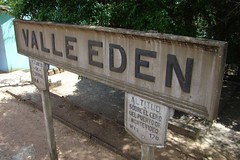 There are two museums in Tacuarembó: the Historical and the Geoscience Museum. None of them is notable, but they were OK for a brief visit. None had air conditioning. The lady who sat (in supreme boredom) at the reception of the Geoscience Museum made a note out of that, while she guided us around a room where labels made her explanations wholly unnecessary.
There are two museums in Tacuarembó: the Historical and the Geoscience Museum. None of them is notable, but they were OK for a brief visit. None had air conditioning. The lady who sat (in supreme boredom) at the reception of the Geoscience Museum made a note out of that, while she guided us around a room where labels made her explanations wholly unnecessary.Near noon we headed for the bus terminal to wait for the bus that would take us to Valle Edén, 23 km from Tacuarembó, a recommended touristic spot which promised lots of green, water and cool, besides being the seat of the Carlos Gardel Museum. Said museum showcases abundant proofs that Gardel, the most famous of all tango singers, was born in Tacuarembó, the bastard son of a promiscuous military man, and not in France... although those proofs are only considered clearly true by the people of Tacuarembó.
The bus came on time, and after about 40 minutes it left us at the entrance to Valle Edén, under a sky pouring sunlight on us. First mistake: the museum is one kilometre from the entrance; if we'd asked for it the bus would've taken us closer. The walk we had to endure was the first step of the realization of what would become painfully obvious later: that Valle Edén was not a summer paradise, unless you have a fast means of transportation (and with A/C).
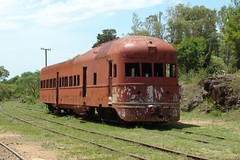 The museum was an oasis of coolness, a house with lots of pictures and copies of historical documents about Carlos Gardel, and tango in the background. We tarried there, on my part without any interest in the hellish outside. Once the tour was over, we sat down to have lunch beside the museum, under some trees. We visited what's left of the Valle Edén train station, where a couple of locomotives are abandoned, giving the visitor a false sense of security (a train came by at full speed a while later). Then, map in hand, I went and inquired about the paths to take in order to reach the curiously named places noted as attractions.
The museum was an oasis of coolness, a house with lots of pictures and copies of historical documents about Carlos Gardel, and tango in the background. We tarried there, on my part without any interest in the hellish outside. Once the tour was over, we sat down to have lunch beside the museum, under some trees. We visited what's left of the Valle Edén train station, where a couple of locomotives are abandoned, giving the visitor a false sense of security (a train came by at full speed a while later). Then, map in hand, I went and inquired about the paths to take in order to reach the curiously named places noted as attractions.There's nothing, nothing in Valle Edén that is close to anything else. The nearest touristic spot was about 7 km from us, maybe feasible for people in better shape or in more moderate temperatures, but not for us two. We didn't recoil from the challenge, though. Following the directions given to me by a local guide, we started walking toward the Gruta de los Chivos (Goats' Cave), but soon we realized that either the map or the guide's tips, or most likely both, bore no relationship to reality. We went back to the starting point, beside a rocky stream, shallow and full of green mud (described in the touristic brochure as having "crystal-clear waters") and near a suspended bridge (which we dared not climb).
By then it was clear the one good idea I had when we decided to try Valle Edén was insisting that we take two litres of cold water with us, despite its weight and the fact that it meant forfeiting our afternoon mate. There's no need, I guess, to note that anyway drinking hot mate at 40 °C was not a priority. We were sweating just by sitting down. And sitting we would have to stay, because the only bus back to Tacuarembó would come after 7 PM. And it was 2.
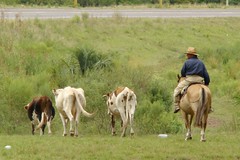 Faced with the prospect of a five-hour wait in that open-air sauna (which was mercifully getting cloudy), we exhausted all conversation topics, including how the hell we'd gotten there and why the guy at Tourist Info didn't explicitly tell us not to go. It was truly very very hot (I can't help repeating that) and we had to be careful with our water.
Faced with the prospect of a five-hour wait in that open-air sauna (which was mercifully getting cloudy), we exhausted all conversation topics, including how the hell we'd gotten there and why the guy at Tourist Info didn't explicitly tell us not to go. It was truly very very hot (I can't help repeating that) and we had to be careful with our water.For a good while we considered going up to the road and hitchhike. But we hadn't seen any hitchhiking in Uruguay, least of all in Tacuarembó. Maybe it wasn't customary, maybe here in the deep interior of the country nobody had that custom. The road didn't look very crowded to us. And beside the road there wouldn't be a lot of convenient waiting places in the shade. We decided against hitchhiking. What to do then?
I'd brought a book, mostly because I had a lot of room in my backpack, thinking maybe we'd lie down in the cool grass in that paradise which Valle Edén had promised to be. I took the book out and started reading, but right away I realized that Marisa, who hadn't brought her own book, would get even more bored watching me read. So I asked her if she wanted me to read aloud. And that was, I think, the second good idea I had in Tacuarembó. The book was Desert Memories, by Ariel Dorfman, an Argentine-born Chilean exilee settled in the United States, and it was about his trip in the north of Chile for a close-up investigation of the history of the towns that sprang up in the late 19th century and early 20th beside the saltpeter mines. Not only was it entertaining and moving, but ideal for travelers like us, ideal to forget the heavy heat, to spend the hours, to stop after a couple of paragraphs and chat and discuss.
At one point when the time to return was still far away and not even the book or the conversations it prompted were enough anymore to keep us calm, we rose and went towards the road. We'd escaped from the dead hours and from our own tempers and we even had some water left, which we now took in little sips. The weather was better as well: the sky was gray and gusts of promising cool wind blew. I started to fear a storm would fall upon us.
At about 6:30 the bus came by, headed for Tambores, the end of its route, from where it would have to return and fetch us. From that moment on the wait became easier. One hour later we saw the same bus come towards us, we signaled it, got in and sat down, so happy.
With almost chronometric precision, it started to rain as soon as we neared Tacuarembó. We had no food for the night, and I had to phone a woman in Paysandú to confirm our reservation for the next day. We ran along the streets; sweating from the day and wet from the rain we went to a supermarket to buy some stuff, and managed to find a public phone. The whole night was a deluge, and thus the coolness we'd wished for the whole day finally came.
01 April 2009
Uruguay 2009, part 13: Tacuarembó
Anyway, Uruguay suffers from the same type of macrocephalic disorder as Argentina, only even more pronounced; if Buenos Aires and its metropolitan area hold between one third and one fourth of the Argentine population, half of the Uruguayan population (which is only one tenth of that of Argentina) is concentrated on the Montevideo Department. That is to say that all roads lead to Montevideo. Or, to make a long story short, there's no direct route from Rocha to Tacuarembó. The traveller who wants to reach the gaucho heart of the country has no other recourse but to go first west-southwest to Montevideo and then wait for another bus to take him north-northeast to Tacuarembó. You go to a place 365 km away (as the crow flies) but you have to travel some 560 km, including a few tens of kilometres going on the opposite direction as the one desired.
So despite our intentions we did go back on our steps, although our stay in Montevideo was much shorter; by a fortunate coincidence, the bus that took us away from a cool night in La Pedrera at 6:30 left us in Tres Cruces, Montevideo, four hours later, and less than an hour before the departure of the bus to Tacuarembó.
The trip was rather long: about five hours (that's long for Uruguayan standards). Half asleep, we entered a flat, green country of scattered cows and sheep. Map in hand, but with no real knowledge of actual geography, I tried to guess at and remember the names of towns and cities we were passing by. I knew we were going to cross several department capitals and a great river... We got to Durazno (what a beautiful name, I thought¹) and then, much later, when I'd started to lose hope of seeing running water ever again, I saw a bridge, a watery expanse, and bam, in a matter of seconds we'd crossed over a blue river, its banks lined with trees, and there waving at us was a huge yellow sign with the black silhouette of a bull, the mark of the most famous of tonic waters in both our countries (when I was little I believed "tonic water" was just a non-commercial way of saying Paso de los Toros).² Of course, of said tonic water only the brand is left, acquired by a multinational consortium which surely claims to be making it "with the same coolness as ever", or something like that.
¹ Durazno means "peach".Coming to Tacuarembó and getting off the bus was literally a thermal shock. From the marine coolness and the Montevidean air conditioning we had emerged directly into the subtropical weather of a land-locked city. And it was 4 PM, and in the Tacuarembó bus terminal there was no A/C. We went to the tourist office, where we were informed that touristic spots in Tacuarembó are located outside the city and in no way made easily accessible to visitors by bus.
² Paso de los Toros is the second city of Tacuarembó Department. Its name means "bulls' crossing", referring to the ford on the Río Negro beside which the city is located. It's also the brand name of a soft drink originally made there and still sold widely in Uruguay and Argentina.
Unraveled and sticky, we marched, backpacks over our shoulders, into the city center and towards our hotel, which turned out to be a curious but eventually satisfactory mix between disarray and amplitude. After the almost forgotten days in the confusing barracks that was the hostel of La Paloma, and the couple of days in the cozy but too little room in La Pedrera, with its doorless bathroom, this was paradise. We had a shower and, braving the awful heat outside, we went out for a walk.
Tacuarembó is a village — a village of fifty-odd thousand, scattered, but a little town anyway, with summer afternoons empty until sunset, lots of young guys in motorbikes, a big square in the middle, a main street on each side of the square and a church just over there. If even walking in the shade hadn't been exhausting, I'm sure we could've enjoyed it more. As things went, there wasn't much to see, so we took the road towards the only tourist attraction we could reach on foot, the Lavenders' Lagoon (Laguna de las Lavanderas).
Even if a picture is worth a thousand words, one has to note that those words can be lies. The postcard images of the Lavenders' Lagoon showed a beautiful watery mirror surrounded by greenery and shade; only by coming close you would notice that the calm water was in fact stagnant. There was indeed much life and green stuff there, but it felt yucky just thinking of touching the water with the tip of a toe.
We fled, therefore, and back in the city, after crossing a bridge painted in bright, desaturated colours (the multicolour logo of the Municipality of Tacuarembó), we got into a cybercafé, and after that we went looking for a place to eat. We shared a huge sandwich and a beer in a bar, sitting next to two young foreign tourists of Anglo-Saxon speech habits and backpacker looks, who for some strange reason (such is the way of globalization) had ended up in this same little corner of the planet as us.
We were in front of the main square, which was filling up, and beside the main street, buzzing with little motorbikes and scooters. I'm emphasizing the bikes because it seems to be a common feature of middle-sized towns where public transport is scarce or nonexistent; in Chilecito, La Rioja, we'd observed that each and every youth seemed to have a motorbike, small or big, old or new, but always a means of transportation for their own use, relatively small and inexpensive, so as to be free from the alternative of a long, slow walk vs. an expensive taxi.
In Tacuarembó, of course, the boys came in motorbikes or bicycles carrying their thermos and mate, showing a kind of manual dexterity I couldn't hope to imitate; they parked at the square, turned on their music, chatted and drank mate. None or almost none of beer or wine or alcoholic drinks, which in Argentina and in squares and in every public place where young people gather tend to mix and turn inevitably into insolence and violence. It was still early, sure, but these guys seemed to be ready to stay, and neither boys nor girls looked any less happy or entertained than their Argentine counterparts, who (rather sadly) claim or assume they need some alcohol blood content to have fun.
These observations having been made, and with a few good, cold glasses of beer in our bloodstream, we wrapped up dinner and went back to the hotel to have some rest.

